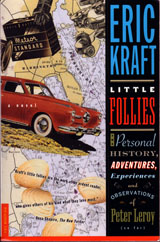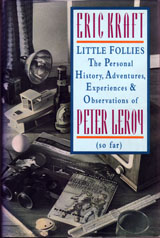

| Little Follies
Life on the Bolotomy Chapter 4: The Adventurer’s Bubble |
by Eric
Kraft, as Peter
Leroy
|

YOU CAN READ THE FIRST HALF
YOU CAN ORDER THE
|
Opens High Road to Adventure 
All the Adventurer’s Needs Are Supplied The adventurer sits comfortably inside the bubble in a clever sling-type arrangement. Close at hand is an ingenious set of closed cabinets and crannies (adapted from IC Plan Set 3355) that hold the essentials for any journey. Here you will find a first-aid kit, fishing gear, collapsible cookstove, nesting utensils, food lockers, built-in water cans, short-wave sending and receiving set, quadrant for celestial navigation, map table, uncanny collapsible latrine outfit, and a deck of playing cards. Don’t look for a tent, though! You won’t find one because the adventurer won’t need one. Like the turtle, the adventurer travels inside his shelter! (Want to build a tent anyway, just for the hell of it? Send for Plan Set 185 or 987).
Materials Are Easily Obtainable The scrap heaps behind your local heavy industries should yield most of the materials needed for the bubble, but if you do encounter any trouble acquiring the needed supplies, be inventive! If you followed last month’s instructions for making a convertible out of your sedan, you’ve got a spare roof on your hands! That sheet metal would go a long way toward the construction of a bubble. Think about starting a home sedan-conversion business. If you convert your neighbors’ sedans, you’ll have plenty of sheet metal for your bubble and a few extra bucks in your pocket besides. Construction Is Simplicity Itself With just a few simple tools, such as a hammer, chisel,
saw, drills, and portable welding outfit, you can build a bubble in those
wasted evening hours after work. (No tools? With Tool Outfit
326, you can fit yourself out with a neat workshop in the garage or barn
where you can build a bubble without annoying disturbances from your loved
ones. Don’t have a garage or barn? Order Plan Set 6024 for
an inflatable rubber garage or Plan Set 2214 for a barn constructed of
laminated back issues of IC. No welding experience?
You can learn welding at home in six short months of spare time.
Order Home Study Course 319.)
(Continued on page 194)
|
 |
||

Here are a couple of swell ideas from Eric Kraft's vivacious publicist, Candi Lee Manning: Tip the author.
Add yourself to our e-mailing list.
|
Little Follies is a work of fiction. The characters, incidents, dialogues, settings, and businesses portrayed in it are products of the author’s imagination and are not to be construed as real. Any resemblance to actual events or persons, living or dead, is entirely coincidental. All rights reserved. No part of this book may be reproduced or transmitted in any form or by any means, electronic or mechanical, including photocopying, recording, or by any information storage and retrieval system, without permission in writing from the author. “My Mother Takes a Tumble,” “Do Clams Bite?,” “Life on the Bolotomy,” “The Static of the Spheres,” “The Fox and the Clam,” “The Girl with the White Fur Muff,” “Take the Long Way Home,” and “Call Me Larry” were originally published in paperback by Apple-Wood Books. Little Follies was first published in hardcover by Crown Publishers, Inc., 201 East 50th Street, New York, New York 10022. Member of the Crown Publishing Group. YOU CAN ORDER THE
For information about publication rights outside the U. S. A., audio rights, serial rights, screen rights, and so on, e-mail the author’s imaginary agent, Alec “Nick” Rafter. The illustration at the top of the page is an adaptation of an illustration by Stewart Rouse that first appeared on the cover of the August 1931 issue of Modern Mechanics and Inventions. The boy at the controls of the aerocycle doesn’t particularly resemble Peter Leroy—except, perhaps, for the smile. |
|
||||||
| . | . |